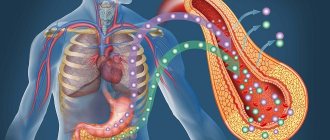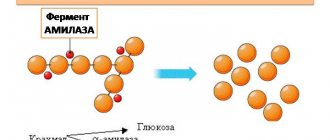Amylase and lipase are digestive enzymes. Their quantity in the bloodstream is used to diagnose the condition of the pancreas if pancreatitis is suspected. Tests can be carried out on the direction of a doctor or at the request of the patient himself, but only a specialist can interpret the results and, if necessary, prescribe treatment. To obtain the most accurate results, special preparation is required before donating blood. For 10 hours before the tests, you must stop eating and avoid significant physical activity and stress.
Lipase test
Lipase is an enzyme that is necessary for the breakdown of fats. The results of a blood test for lipase play an important role in the diagnosis of diseases such as obstruction of the pancreatic duct and pancreatitis in acute or chronic form. Reference values for this enzyme are 13-60 IU/L. If the test results are within these values, this indicates that at the moment the pathological process does not affect the pancreas.
Increased performance
may indicate acute or chronic inflammation, neoplastic changes, traumatic damage to the pancreas, or blockage of its ducts. It is impossible to make an accurate diagnosis and select an effective treatment method based on the results of one test. For this purpose, an examination is prescribed, which may include both laboratory tests and instrumental studies.
Concentration too low
enzyme in the blood may indicate a decrease in the functional activity of the pancreas or cystic fibrosis. Determination of lipase levels has a high diagnostic value in identifying various pancreatic pathologies. The enzyme is produced only by the cells of this organ, so it can be used as a marker of its condition.
When interpreting the results, the patient’s age, clinical picture, results of other studies and other factors are taken into account.
Detailed description of the study
Pancreatic lipase is a water-soluble enzyme that catalyzes the reactions of digestion of neutral fats (triglycerides) in the initial part of the small intestine - the duodenum. The biochemical feature of lipase is that this enzyme can perform its function without coenzymes - derivatives of vitamins, nucleotides, heme, etc.
The process of digestion of triglycerides begins in the lumen of the stomach with the help of lingual lipase, which is produced in the glands of the tongue and enters the stomach along with saliva. However, the main stage of digestion of neutral fats begins in the small intestine. Pancreatic lipase is formed in the pancreas and, as part of pancreatic juice, is secreted through the duct into the lumen of the duodenum together with colipase. This protein indirectly accelerates the action of lipase, so that fats begin to break down faster.
Before digestion, fats sequentially pass through the emulsification stage. Bile produced in the liver directly produces this process - the integrity of the neutral fat molecule is disrupted, as a result of which triglycerides are repeatedly mixed with water in the lumen of the small intestine and crushed into small fat droplets. After this, the process of hydrolysis begins with the participation of pancreatic lipase.
With pancreatitis, the outflow of pancreatic juice into the duodenum is disrupted. The large amount of lipase and other enzymes remaining in the gland, which have pronounced biological activity, leads to inflammation of the “self-digestion” type - the enzymes destroy the anatomical structure of the pancreas and become the main cause of the development of inflammation. In this case, a significant part of the lipase begins to enter the blood. In addition, lipase together with calcium leads to extensive damage to the pancreas (pancreatic necrosis).
Another enzyme, alpha-amylase, is also a marker of pancreatitis. This protein is formed in the cells of the salivary glands and pancreas; it is involved in the hydrolysis of carbohydrates. With pancreatitis, the pancreatic form of amylase in the blood increases, and salivary amylase levels remain within normal values. Accordingly, hyperfermentemia (increased lipase or amylase in the blood) by more than three times is one of the key signs of acute pancreatitis.
In the context of diagnosing acute pancreatitis, lipase is a more specific enzyme than amylase. An increase in the level of lipase in pancreatitis is observed approximately 4-8 hours after the onset of the disease, amylase - 2-12 hours. In this case, the level of lipase in the blood, as a rule, increases to a greater extent and can remain elevated much longer compared to amylase (7-10 days / 3-4 days). It has also been found that in about 20% of patients, the concentration of serum amylase can remain within normal limits. This property is not typical for lipase.
Also, the level of serum pancreatic lipase may be increased in diseases of the hepatobiliary region and systemic diseases leading to secondary damage to the pancreatic gland.
Amylase test
Amylase is an enzyme that is responsible for the breakdown of carbohydrates. It, unlike lipase, is produced not only by the pancreas, but also by the salivary glands. In addition, some amount of the enzyme is produced in the skeletal muscles, intestines and ovaries. A blood test for amylase is prescribed to patients with acute or chronic pancreatitis, if pathology of the ovaries or salivary glands is suspected.
In patients over 18 years of age, the enzyme level should not exceed 53 U/l. The norm for children varies depending on their age. The level of pancreatic amylase is analyzed by the doctor taking into account the total amount of enzyme. In acute pancreatitis, in most cases there is a significant increase in the amount of pancreatic enzyme. Sometimes the increase in indicators is insignificant or they remain within normal limits. The test results do not reflect the degree of damage to the pancreas, so a comprehensive examination is performed to confirm the diagnosis and develop a treatment regimen. An increase in indicators can be caused not only by pancreatitis, but also by traumatic damage to the pancreas, its oncology, blockage of the pancreatic duct, rupture of an aortic aneurysm, perforated ulcer, peritonitis, intestinal obstruction and other pathologies.
In acute pancreatitis,
amylase levels usually rise before lipase levels
. The lipase concentration remains high longer. To obtain a complete picture, a study to determine the amount of these two enzymes is carried out simultaneously.
Amylase
Amylase is one of the enzymes of digestive juice, which is secreted by the salivary glands and pancreas.
Research method
Kinetic colorimetric method.
Units
U/L (unit per liter).
What biomaterial can be used for research?
Venous blood.
How to properly prepare for research?
- Do not eat for 12 hours before the test.
- Avoid physical and emotional stress and do not smoke 30 minutes before donating blood.
General information about the study
Amylase is one of several enzymes that are produced in the pancreas and are part of pancreatic juice. Amylase breaks down carbohydrates. From the pancreas, pancreatic juice containing amylase passes through the pancreatic duct into the duodenum, where it helps digest food.
Normally, only a small amount of amylase circulates in the bloodstream and ends up in the urine. If the pancreas is damaged, as in pancreatitis, or if the pancreatic duct is blocked by a stone or tumor, amylase begins to leak into the bloodstream in large quantities and then into the urine.
Small amounts of amylase are produced in the ovaries, intestines, bronchi and skeletal muscles.
What is the research used for?
- To diagnose acute or chronic pancreatitis and other diseases involving the pancreas in the pathological process (together with a lipase test).
- To monitor treatment for cancer affecting the pancreas.
- To ensure that the pancreatic duct is not compromised after removal of gallstones.
What do the results mean?
Reference values: 28 - 100 U/l.
Reasons for increased activity of total amylase in serum
- Acute pancreatitis. With this disease, amylase activity can exceed the permissible level by 6-10 times.
- Chronic pancreatitis.
- Trauma to the pancreas.
- Pancreas cancer.
- Blockage (stone, scar) of the pancreatic duct.
- Acute appendicitis, peritonitis.
- Perforation (perforation) of a stomach ulcer.
- Decompensation of diabetes mellitus – diabetic ketoacidosis.
- Impaired flow in the salivary glands or salivary ducts, for example with mumps (mumps).
- Operations on the abdominal organs.
- Acute cholecystitis is inflammation of the gallbladder.
- Intestinal obstruction.
- Aborted tubal pregnancy.
- Ruptured aortic aneurysm.
Reasons for decreased activity of total amylase in serum
- Decreased pancreatic function.
- Severe hepatitis.
- Cystic fibrosis.
- Removal of the pancreas.
What can influence the result?
- Serum amylase activity increases: in pregnant women,
- when taking captopril, corticosteroids, oral contraceptives, furosemide, ibuprofen, narcotic analgesics.
Important Notes
- In acute pancreatitis, an increase in amylase is usually accompanied by an increase in lipase activity.
- Amylase activity in children is low in the first two months of life; it rises to adult levels by the end of the first year.
Determination of alpha-amylase activity in urine (diastase)
Short description:
Amylase is an enzyme produced in the pancreas and salivary glands. Marker of pancreatic lesions (pancreatitis). Significant amounts of serum amylase are excreted in the urine, so an increase in serum amylase is reflected in an increase in urinary amylase. Amylase activity in urine is increased more often and more significantly than amylase activity in serum; the increase in values lasts for a longer period. Synonyms (rus): urine amylase. Synonyms (eng): Urine Amy, Urine Alpha-amylase, Urine AML, Urine diastase, Urine amylase. Method: Kinetic colorimetric.
Units of measurement: U/l. (unit per liter).
Preparing for the study:
• Do not drink alcohol for 24 hours before the test, and do not drink diuretics for 2 days. • Eliminate spicy, salty foods and foods that change the color of urine (for example, beets, carrots) from the diet 12 hours before the test. • Avoid physical and emotional stress during the collection of daily urine (during the day).
Type of biomaterial: Single portion of urine.
Service price: 100 rub.
Completion time: one business day.
Reference values:
Gender Reference values Female 21 - 447 U/l. Male 16 - 491 U/l.
Reasons for increased amylase activity in urine: • Acute pancreatitis. In this disease, amylase activity can exceed the upper reference value by 6-10 times. Typically, its activity in urine increases 6-8 hours after damage to the pancreas and can remain at a high level for up to 2 weeks. However, in some patients with acute pancreatitis, amylase may increase slightly or even remain normal. In general, its activity does not reflect the severity of damage to the pancreas in this disease. • Chronic pancreatitis. With it, the activity of urine amylase is initially moderately increased, but then it can decrease and return to normal as the damage to the pancreas worsens. • Trauma to the pancreas. • Pancreas cancer. • Blockage (stone, scar) of the pancreatic duct. • Acute appendicitis, peritonitis. • Perforation (perforation) of a stomach ulcer. • Decompensation of diabetes mellitus – diabetic ketoacidosis. • Impaired flow in the salivary glands or salivary ducts, such as with mumps (mumps). • Surgery on the abdominal organs. • Acute cholecystitis – inflammation of the gallbladder. • Intestinal obstruction. • Aborted tubal pregnancy. • Rupture of aortic aneurysm.
Reasons for decreased amylase activity in urine: • Pancreatic insufficiency, when its function decreases. • Chronic renal failure. • Severe hepatitis. • Cystic fibrosis (cystic fibrosis) of the pancreas is a severe hereditary disease associated with damage to the exocrine glands (lungs, gastrointestinal tract). • Removal of the pancreas. • Macroamylasemia is a rare benign condition where amylase binds to large proteins in the serum and therefore cannot pass through the glomeruli.
Code A09.28.027







